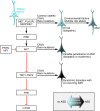The genetic and neurobiologic compass points toward common signaling dysfunctions in autism spectrum disorders
- PMID: 19339766
- PMCID: PMC2662567
- DOI: 10.1172/JCI37934
The genetic and neurobiologic compass points toward common signaling dysfunctions in autism spectrum disorders
Abstract
Autism spectrum disorder (ASD) is a common neurodevelopmental disorder with high heritability. Here, we discuss data supporting the view that there are at least two distinct genetic etiologies for ASD: rare, private (de novo) single gene mutations that may have a large effect in causing ASD; and inherited, common functional variants of a combination of genes, each having a small to moderate effect in increasing ASD risk. It also is possible that a combination of the two mechanisms may occur in some individuals with ASD. We further discuss evidence from individuals with a number of different neurodevelopmental syndromes, in which there is a high prevalence of ASD, that some private mutations and common variants converge on dysfunctional ERK and PI3K signaling, which negatively impacts neurodevelopmental events regulated by some receptor tyrosine kinases.
Figures



References
-
- American Psychiatric Association. 1994.Diagnostic and statistical manual of mental disorders. 4th edition. American Psychiatric Association. Washington, DC, USA. 886 pp.
-
- Thatcher R. Psychopathology of early frontal lobe damage: dependence on cycles of development. Dev. Psychopathol. 1994;6:565–596. doi: 10.1017/S0954579400004697. - DOI
-
- Hammock E.A.D., Levitt P. The discipline of neurobehavioral development: the emerging interface of processes that build circuits and skills. Hum. Dev. 2006;49:294–309.
Publication types
MeSH terms
Substances
LinkOut - more resources
Full Text Sources
Other Literature Sources
Medical
Miscellaneous

